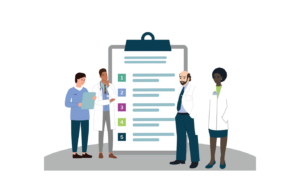Three Essential Elements of Effective Patient Messaging
By Blakely Roth | April 3, 2024
Effective communication between healthcare providers and their patients is the cornerstone of high-growth practices. When practices actively reach out to their patients about upcoming appointments, office updates and last-minute provider changes, patients feel informed and valued – which drives patient loyalty and retention.
A recent survey by Redpoint Global and Dynata found that two-thirds of the more than 1,000 U.S. healthcare consumers polled say “Selecting a provider was dependent on the provider’s ability to communicate to them in a timely and consistent manner.” From a provider perspective, this means consistent revenue that transforms the practice into a high-growth powerhouse.
There are many different communication tools that you can use to take your practice to the next level, including appointment reminders, patient recalls and mass messaging. In this blog, we’re going to focus on one-to-many administrative messaging, but for more information on all three communications solutions, check out our recent guide, “3 Ways To Use Patient Communications to Boost Revenue.”
Make Patient Messaging a Revenue Driver
Administrative patient messaging, also commonly referred to as broad patient messaging, provides practices with the ability to automatically send practice updates to a broad or targeted patient base.
Automated messaging is crucial today, considering 40% of providers say staff shortages have been offset by technology improvements. In a healthcare landscape battling staff turnover and limited resources, this capability is more important for practices today than ever before.
It’s important to note, however, that not all mass messaging tools work the same way – and the success you have will likely depend on the features your solution offers.
The most effective messaging tools – and those that can have the greatest impact on the bottom line – offer innovative features that allow practices to tailor messages based on their unique needs. With this in mind, here are three of the most impactful features of a patient messaging tool that can help accelerate revenue streams for your practice, while providing the communications today’s patients require:
1. Customization: With the ability to customize and personalize your patient messages, you can significantly increase the likelihood that recipients will take action. For example, when a generic email or text comes in from any organization – a provider, a retail outlet, a restaurant, etc. – most people’s first instinct is to delete it. If it isn’t specialized, it doesn’t seem important, urgent or relevant. However, when you’re able to personalize a mass message by including specific information, such a patient’s name, their doctor’s name and appointment type, you increase your chance of grabbing patients’ attention and inciting them to act.
For example, when you need to contact a group of patients to let them know their provider will be out unexpectedly today and they’ll have to reschedule their appointments, with customized messaging you can ensure that they follow-through on the action to reschedule. Without specifics in your message, your patients could mistake the message for spam and avoid rebooking.
Patient communications that are personalized with the right message and delivered to the right audience can help you build patient loyalty and increase the lifetime value of your existing patient base, while increasing bookings and rescheduling when needed.
2. Scheduling links: Equally as important to getting the right message and audience, is being able to include a scheduling link so patients can book, modify or cancel appointments without having to contact your office staff.
If you have to shut your office down due to inclement weather for example, you can send a targeted message to today’s patients and include a scheduling link! You won’t need to rely on staff to call patients and rebook them, instead, you can send a scheduling link in the initial message and enable patients to quickly get back on the schedule — all without staff intervention.
This step also helps to reduce phone traffic and potential patient loss. Without a convenient scheduling link in the message, if a patient sees the promotion and calls to book, they may get stuck on hold and eventually hang up, causing you to lose that booking and revenue.
3. Targeted message delivery options: Smart patient messaging tools allow practices to target patients by appointment service/type, date, time, status, provider or location. This flexibility is important because it gives your practice the option to target specific patients, for more personalized reach-out requirements. This type of customization enables you to adapt more strategically to administrative needs and better leverage automated to reduce staff work as a result.
For example, if a practice wants to send an update regarding an urgent item (e.g., an office closure) or notify patients of a last-minute practice/provider change (e.g., a doctor is out of the office), then the ability to send a message only to patients with appointments at that specific location or with that specific provider. You can use a targeted patient message to notify only their patients that they will need to reschedule their upcoming visit. This one action saves your staff significant time, instead of leading them to call and rebook each patient.
If all patients received these messages, then some would be getting an irrelevant message. When patients receive messages that are not relevant to them, they may decide to opt out of these important communications or ignore future communications, which is what you need to avoid.
Scheduling targeted patient messages helps to reduce staff burdens, giving them the flexibility to complete the communication trifecta: targeting the right audience, with the right message at the right time.
Enhance Patient Loyalty, Bookings and Revenue
Good patient communication is one of the most impactful ways healthcare practices can gain new patients, reduce no-shows and increase profits. With lean staff numbers and shifting patient expectations, patient communications have become a bigger challenge for practices. Download this guide to learn how you can meet patient expectations with fewer staff.
To find out how Clearwave can help you leverage mass messaging to maximize revenue potential, contact us today.




